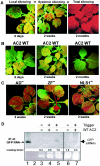Suppression of RNA silencing by a geminivirus nuclear protein, AC2, correlates with transactivation of host genes
- PMID: 15681452
- PMCID: PMC546592
- DOI: 10.1128/JVI.79.4.2517-2527.2005
Suppression of RNA silencing by a geminivirus nuclear protein, AC2, correlates with transactivation of host genes
Abstract
Bipartite geminiviruses encode a small protein, AC2, that functions as a transactivator of viral transcription and a suppressor of RNA silencing. A relationship between these two functions had not been investigated before. We characterized both of these functions for AC2 from Mungbean yellow mosaic virus-Vigna (MYMV). When transiently expressed in plant protoplasts, MYMV AC2 strongly transactivated the viral promoter; AC2 was detected in the nucleus, and a split nuclear localization signal (NLS) was mapped. In a model Nicotiana benthamiana plant, in which silencing can be triggered biolistically, AC2 reduced local silencing and prevented its systemic spread. Mutations in the AC2 NLS or Zn finger or deletion of its activator domain abolished both these effects, suggesting that suppression of silencing by AC2 requires transactivation of host suppressor(s). In line with this, in Arabidopsis protoplasts, MYMV AC2 or its homologue from African cassava mosaic geminivirus coactivated >30 components of the plant transcriptome, as detected with Affymetrix ATH1 GeneChips. Several corresponding promoters cloned from Arabidopsis were strongly induced by both AC2 proteins. These results suggest that silencing suppression and transcription activation by AC2 are functionally connected and that some of the AC2-inducible host genes discovered here may code for components of an endogenous network that controls silencing.
Figures




References
-
- Anandalakshmi, R., R. Marathe, X. Ge, J. M. Herr, Jr., C. Mau, A. Mallory, G. Pruss, L. Bowman, and V. B. Vance. 2000. A calmodulin-related protein that suppresses posttranscriptional gene silencing in plants. Science 290:142-144. - PubMed
-
- Bartel, D. P. 2004. MicroRNAs. Genomics, biogenesis, mechanism, and function. Cell 116:281-297. - PubMed
-
- Baulcombe, D. 2002. Viral suppression of systemic silencing. Trends Microbiol. 10:306-308. - PubMed
Publication types
MeSH terms
Substances
LinkOut - more resources
Full Text Sources
Other Literature Sources
Molecular Biology Databases

